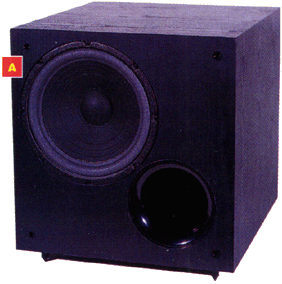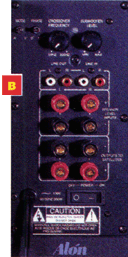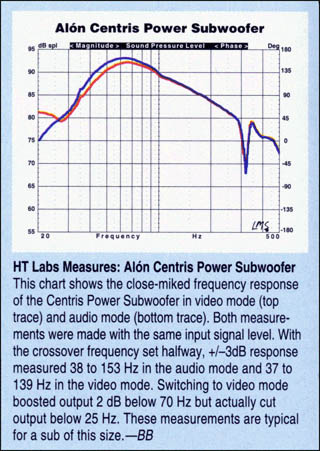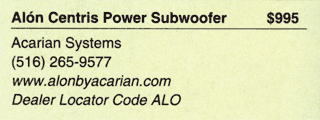October 1999
Alón Centris Power Subwoofer
An audiophile sub with cojones.
by Brent Butterworth


|
|
|
The back panel has line-level and speaker-level inputs and outputs. The speaker-level outputs include a 6-decibel/octave high-pass filter at 150 hertz (assuming an 8-ohm load) to keep the bass out of your satellites, if you don't already have a Dolby Digital receiver or pre/pro that will perform the task for you. It has an 18-dB/octave low-pass filter for the sub itself, with the crossover adjustable from 50 to 200 Hz, plus a phase switch and a "video" switch Alón says will boost output by 6 dB at 35 Hz.
Acarian Systems prez Carl Marchisotto tells me he designed the Centris Power Subwoofer because he couldn't find a subwoofer with the kind of transient response (otherwise known as "speed') found in his Alón Centris home theater speakers. That makes sense to me; we've complained several times that 15- and 18-inch subs are just too massive and slow to reproduce upper-bass frequencies with any kind of punch or pitch definition.
I compared the Centris Power Subwoofer with a variety of subs, including Sunfire's $1,299 True Subwoofer MK.II, Tannoy's $1,250 PS-115 15-incher, D-Box's $399 David 12-incher, and Energy's $300 ES-8. I used Vienna Acoustics' Beethoven main speakers, with their matching center and surrounds, and also tried the Centris Power Subwoofer with some Mission 772 minimonitors and a full set of Alón Centris home theater speakers.

You can tell in about 10 seconds that Marchisotto's claims for his subwoofer are true; this box is clearly built for speed. It easily beat out all the other subs I listened to in terms of pitch definition and punch, except for the super-fast Energy sub, which it equaled. The Centris just kills on electric and acoustic bass lines. It nailed the challenging bass line from "Train Song" off Holly Cole's Temptation CD; larger subs tend to make this bass line sound boomy, and 10- and 8-inch subs often distort audibly on the lowest notes. In the upper-bass region, which I believe is the most important range for bass-line reproduction, I can't think of a sub that beats out this one.
Marchisotto recommended two Centris Power Subs for our room (which measures about 2,693 cubic feet). I tried using two subs, but I was able to get satisfying bass from music CDs with just one. Playing heavy-duty-action movie soundtracks was certainly possible with just one sub, but adding a second made a significant difference-reducing the demand on the subs, decreasing distortion, and even slightly improving their pitch definition.
Unlike most audiophile subs, this one works just fine for rock music-you get plenty of punch from kick drums, plenty enough output to play loud, and, as I mentioned before, you get that pitch definition that makes bass lines sound great. As you might expect, though, the Centris really stands out on jazz, where there's not as much low-frequency content, and its great upper-bass response makes acoustic bass sound like it's right there in the room with you.
The only thing I couldn't get this sub to do perfectly is reproduce bottom-octave bass, which it doesn't even attempt. When I played my favorite low-bass test track, the Michael Murray/San Francisco Symphony recording of Jongen's "Syrnphonie Concertante," the very deep notes of the huge pipe organ were inaudible. But the only 10-inch subs I can think of that will reproduce those notes are the REL Strata II and Stonn, which are really tuned only to do deep bass.
 The Centris Power Sub blended beautifully with the Centris home
theater system; the sound in our slightly deader-than-average room was
so detailed, delicate, and dynamic that I can't imagine any audiophile
finding serious fault with it. It also worked well with the Missions
and the Viennas, and I'd heartily recommend it with any smaller
speaker. You can get more output and low-frequency extension for the
price, but I don't think you can get better pitch definition and
precision anywhere.
The Centris Power Sub blended beautifully with the Centris home
theater system; the sound in our slightly deader-than-average room was
so detailed, delicate, and dynamic that I can't imagine any audiophile
finding serious fault with it. It also worked well with the Missions
and the Viennas, and I'd heartily recommend it with any smaller
speaker. You can get more output and low-frequency extension for the
price, but I don't think you can get better pitch definition and
precision anywhere.
